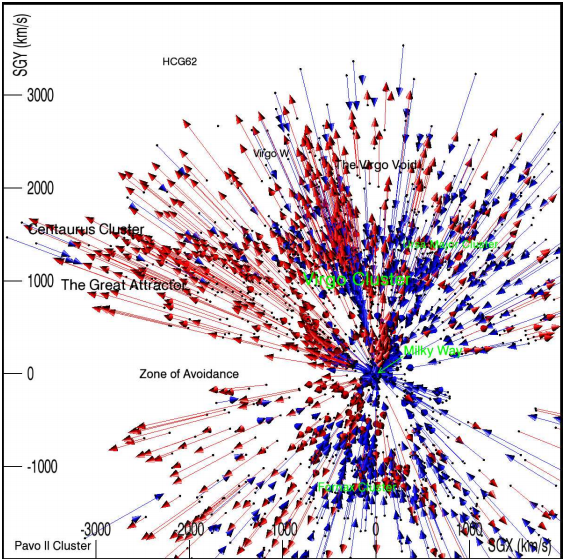
Posted on 06/05/2013 2:51:39 PM PDT by LibWhacker
The three-dimensional structure of the local universe may one day become as familiar as our local geography thanks to a new generation of maps that reveal our neighbourhood’s rich complexity and our place within it

The geography of our world is one of the great cultural invariants. There can hardly be the person on the planet who isn’t familiar with the shape of the continents and how they dovetail together or of the Earth is a pale blue sphere orbiting the Sun with seven other planets.
Given a three-dimensional model of the solar system, almost everyone can zoom in from beyond the Oort cloud to the planet Earth and then even further to the street where they live. It is powerful shared knowledge.
But at greater distances, our geographical knowledge becomes a little blurred. Many people will have seen the extraordinary three-dimensional models of the filamentary structures that galaxies form on the larger scales in our universe.
And yet these structures remain strangely unfamiliar. Given an unlabelled three-dimensional model of this large-scale structure of the universe, who could point to the place we call home?
All that should begin to change in the next few years with the increasingly accurate maps that cosmologists are compiling of the three-dimensional distribution of galaxies within universe.
Today, Helene Courtois at the University of Lyon in France and a few buddies show off this newfound knowledge in a movie (and accompanying paper) that they’ve created to explore the rich structure of our galactic neighbourhood.
One of the key questions that this data can help to answer is whether the distribution of visible mass in the universe is an accurate reflection of the distribution of dark matter. Courtois and co so that the data shows that this is indeed the case.
The film does a fine job of showing the three-dimensional structure of this space. It also reveals the limitations of human language in describing this complex tapestry. That’s not really surprising given that our vocabulary has evolved to describe a geography that is essentially two-dimensional.
Just how to describe our position within the three-dimensional filamentary structure of the universe is a challenge that astronomers will have to wrestle with in the coming years.
And since this presents a rather different challenge than ordinary geography, researchers have coined a new term to describe this kind of intergalactic mapping–cosmography.
We can expect to see more of these kinds of 3D maps of the universe as the data becomes better and more easily accessible. And as cosmography grows into a science in its own right. Perhaps one day they will appear as familiar to us as the shape of the continents on this pale blue dot.
Ref: arxiv.org/abs/1306.0091: Cosmography Of The Local Universe
Thanks colorado tanker, another extra to APoD members.

Was the “Zone of Avoidance” declared by Intergalactic Treaty?
Or is it just a VERY bad neighborhood?
Does it have its own food desert? Its own mosque?
I was thinking the same thing...
"How do you want your human, regular or extra-crispy?"
Disclaimer: Opinions posted on Free Republic are those of the individual posters and do not necessarily represent the opinion of Free Republic or its management. All materials posted herein are protected by copyright law and the exemption for fair use of copyrighted works.